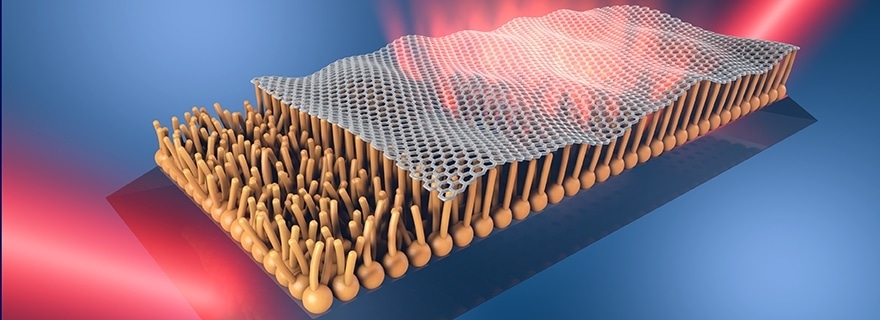Sep 29 2016
 CREDIT: Universiteit Leiden
CREDIT: Universiteit Leiden
Researchers have, for the first time, succeeded in placing a graphene layer on top of a firm fatty lipid monolayer. Graphene, surrounded by a protective shell of lipids, could enter the body and work as a versatile sensor. The findings, recently published in Nanoscale, are the initial steps towards such a shell.
In contrast to earlier research, a stable structure was observed by the researchers when graphene was placed on a single layer of lipids. A patent for these findings has been submitted. This discovery was made by PhD candidate Lia Lima and co-workers under the administration of chemist Grégory Schneider.
Graphene
Graphene, a surface material comprising of a single layer of carbon atoms, is extremely thin, flexible and strong. Graphene is under great demand in the technological world due to its efficient conduction of electricity, and it also has a wide range of applications.
Graphene is particularly sensitive and can respond to its environment in the body.
Grégory Schneider, Chemist, Universiteit Leiden
Future applications for the body include systems and biosensors that assign the exact spot to carry out diagnosis.
Bonding with Graphene
Hard inorganic materials are often used as a support, making graphene ideal for these applications. These hard materials however are not suitable for the use of graphene in the body.
This is the reason that scientists are on the look out for organic, soft molecules to combine with graphene - in this case lipids.
Lipids on Graphene
Lipids are fats present in the cell membrane - the protective layer of a cell. This membrane is made up of a double layer of lipids. Graphene freely passed through the body when it was placed between the two layers.
A method that is already used with cancer medicines. We made a single layer of lipids in the lab and transferred graphene on top: a first step towards mimicking the cell membrane.
Grégory Schneider, Chemist, Universiteit Leiden
Measurements
The researchers in this present study observed that a high-quality support was provided by a lipid layer to graphene. Infrared measurements were used to demonstrate the lipid layer’s stability.
The researchers further discovered that the electrical conduction of graphene was enhanced by lipids, and this effect guarantees potential for future applications. The electrical signals of graphene present in the body can be measured by the progress in electrical conduction. These signals reveal something about the graphene environment, such as the presence of specific proteins or the acidity.
Nanosensor
Graphene could eventually pass through the body when it is stabilized by lipids.
However, we still have a long way to go. The next step is to place a lipid layer on both sides of graphene, like a sandwich.
Grégory Schneider, Chemist, Universiteit Leiden
The research publication has been featured on the cover of Nanoscale